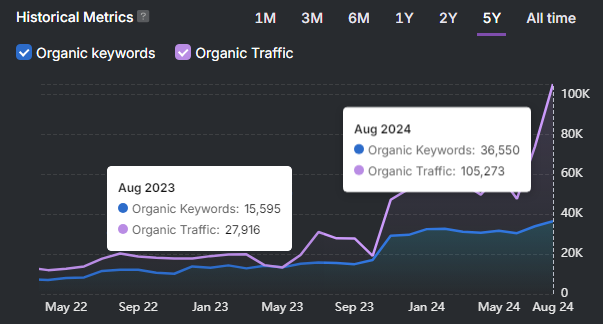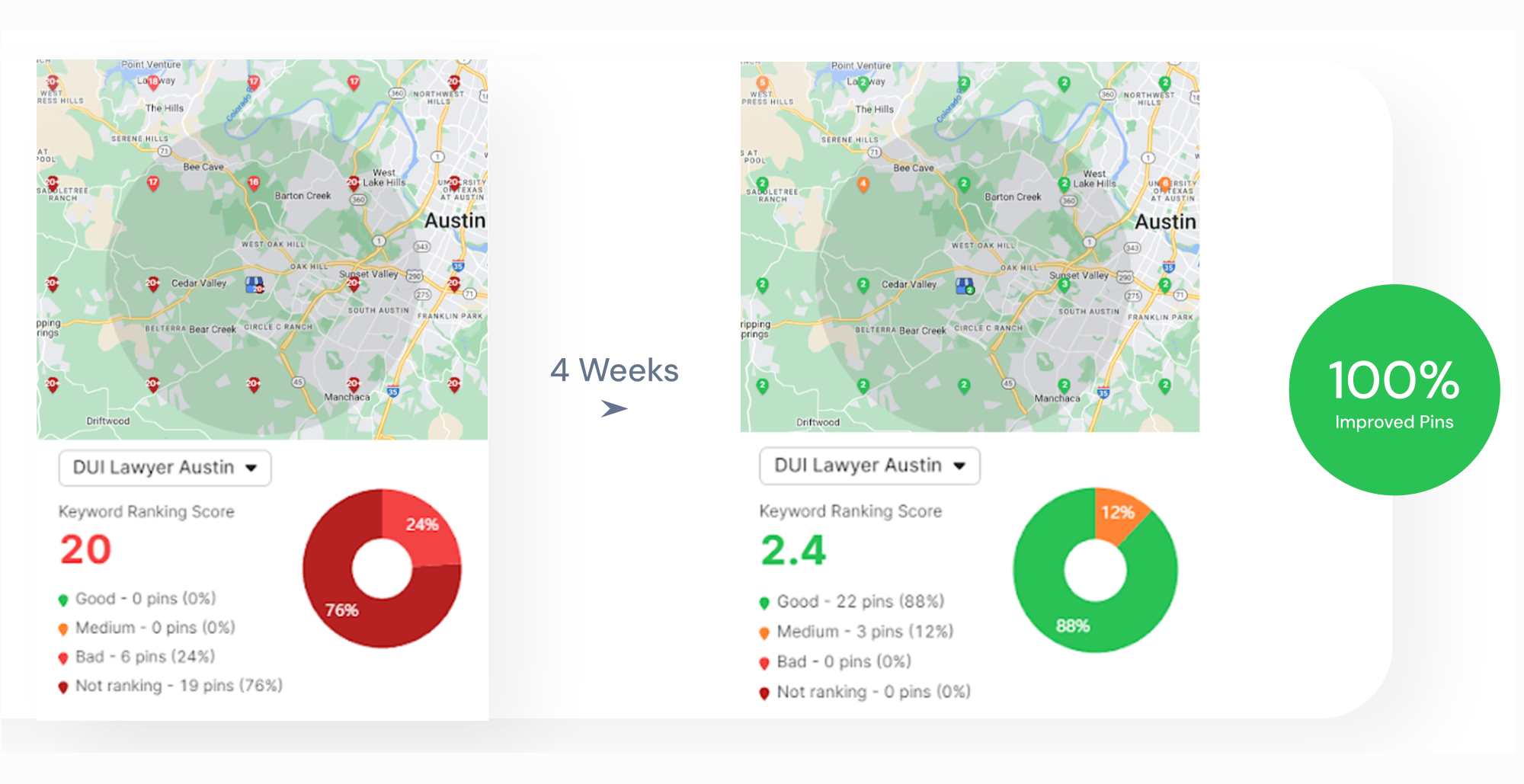Holistic SEO refers to an all-around approach to search engine optimization that integrates all aspects of website performance. The holistic SEO approach for websites combines four essential pillars known as the XACT framework (User Experience (X), Authority (A), Content (C), and Technicals (T)). Holistic SEO builds a complete digital ecosystem where each component reinforces the others and creates stronger signals for search engines and better experiences for users.
Holistic SEO aligns with how modern search engines evaluate websites. Google uses thousands of ranking factors, which all work together to determine a site’s position in search results. Implementing holistic SEO strategies like earning highly relevant backlinks and publishing topical clusters helps websites build sustainable organic traffic growth and become more resilient to algorithm updates.
What is Holistic SEO?
Holistic SEO is a search engine optimization approach that improves a website by optimizing four interconnected areas of User Experience (UX), Authority, Content, and Technical SEO. Holistic SEO meaning focuses on treating a website as a unified system where every part works together to increase organic rankings.
The goal of holistic SEO is to create a website that delivers better user signals, builds domain authority, offers valuable content, and maintains technical health.
Holistic SEO includes improving site speed and mobile usability to enhance UX. Holistic SEO includes earning backlinks from authoritative websites to improve authority. It includes creating semantically rich content to cover topics in depth and meet user intent. It includes fixing crawl errors and optimizing site structure to improve technical SEO.
Holistic SEO improves rankings because Google evaluates websites across many signals. Neglecting any holistic SEO pillar weakens the entire system. Holistic SEO builds resilience because it balances pillars such as UX, Authority, Content, and Technical SEO in one strategy.
Websites that apply holistic SEO grow sustainably and perform better during algorithm updates because their ranking signals work together and holistically.
What are the 4 Pillars of the Holistic SEO Approach?
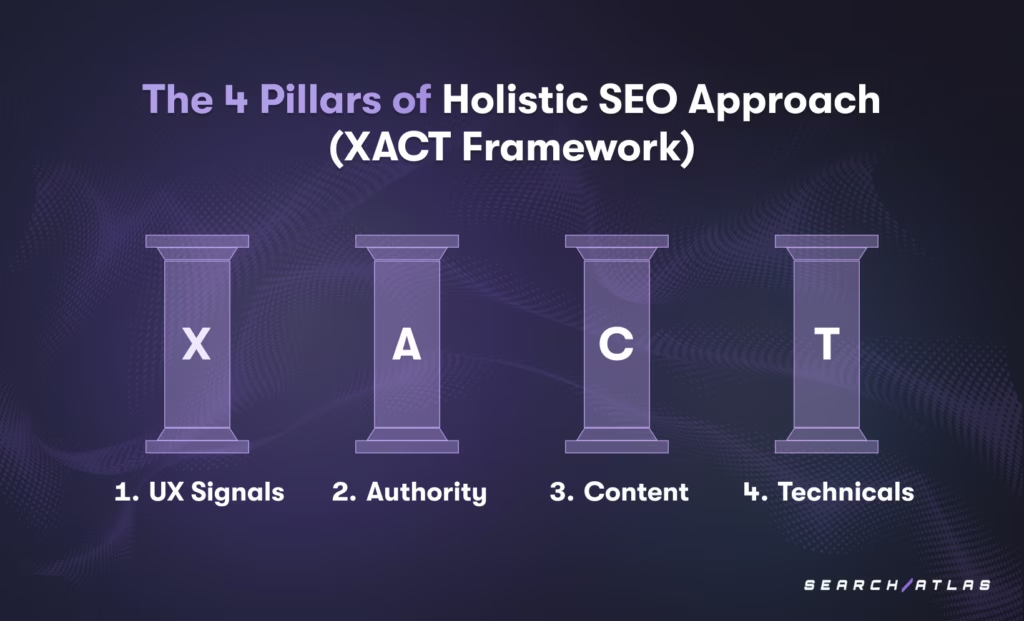
The 4 pillars of a holistic SEO approach are defined by the XACT SEO Framework, as introduced by Search Atlas. XACT stands for User Experience (X), Authority (A), Content (C), and Technicals (T). These 4 pillars are the core areas Google considers when ranking websites. The XACT framework (4 pillars) helps SEO marketers build a well-rounded SEO strategy that aligns with how search engines evaluate and reward high-quality sites.
The 4 Pillars of Holistic SEO approach are listed below.
1. User Experience (UX) Signals.
User Experience (UX) signals are measurable behaviors that show how users interact with search results and website content. User Experience signals affect search rankings because they reveal user satisfaction, relevance, and ease of interaction based on live feedback.
User behaviors that create UX signals include click-through rates (CTR) on search listings, dwell time on pages, bounce rates, pogo-sticking, and branded navigational queries. Engagement with SERP features (featured snippets, rich snippets, knowledge panels) reflects the quality of interaction before users visit a website.
Metrics and KPIs that indicate strong User Experience signals include high CTR, long dwell time, low bounce rate, high pages-per-session, frequent branded queries, and successful engagement with featured content. Google ranking models, such as the Navboost Algorithm and Real-Time Engagement (RTE) system, adjust rankings dynamically based on these user behavior patterns.
2. Authority Signals.
Authority signals are trust indicators that demonstrate a website’s reputation, credibility, and expertise to search engines. Authority signals include off-page SEO factors, local SEO signals, brand-driven trust indicators, and social amplification signals. Authority signals affect search rankings because they guide search systems toward sites that are trustworthy, knowledgeable, and consistently reliable.
Elements that contribute to authority signals include backlinks from trusted domains, citations from credible sources, brand-driven navigational queries, brand mentions across reputable platforms, engagement with authoritative content, local citation consistency, and social media interactions that drive brand visibility. Google evaluates off-page SEO siteAuthority, publisher trust, homepage PageRank, and link credibility to measure a domain’s reputation and trustworthiness.
Metrics and KPIs that reflect strong authority signals include high Domain Power, a diverse and high-quality backlink profile, consistent brand queries, strong trust flow (TF), high referring domain counts, NAP (Name, Address, Phone) consistency for local SEO signals, strong brand entity recognition, and a low spam score. The presence of trusted anchor text, natural link diversity, and clean backlink profiles strengthens authority further.
Google’s internal models confirm that domain reputation, publisher trust signals, PageRank variations, and external trust indicators are integral to ranking evaluations.
3. Content Signals.
Content signals are indicators that show the depth, breadth, relevance, and topical authority of a website’s published material. Content signals affect search rankings because they demonstrate how well a website satisfies search intent, covers semantic relationships, and maintains high-quality topical clusters.
Elements that contribute to content signals include on-page SEO optimization, development of comprehensive content clusters, expansion of semantic breadth across related entities, maintenance of strong contextual relevance within articles, and building of topical authority through structured internal linking and hierarchical coverage. Google’s natural language processing (NLP) models analyze content SEO to evaluate topical relevance, entity relationships, contextual coherence, and content completeness.
Metrics and KPIs that reflect strong content signals include high content quality scores, complete keyword coverage across topical maps, entity saturation scores based on semantic clustering, freshness frequency of updated content, and internal link density between related pages. Google’s ranking systems prioritize on-page SEO optimized websites that demonstrate depth, breadth, relevance, and semantic cohesion through their content networks.
4. Technical Signals.
Technical signals are indicators that show a website’s accessibility, crawlability, indexability, and security compliance for search engines. Technical signals affect search rankings because they ensure that a website can be properly discovered, loaded, and interpreted without barriers or risks.
Elements that contribute to technical signals include fast-loading pages, mobile-responsive layouts, stable server uptime, correct SSL/HTTPS implementation, and structured data markup for enhanced crawling. Site architecture, clean URL structures, robots.txt optimization, sitemap configuration, and the absence of critical crawl errors support technical health.
Metrics and KPIs that reflect strong technical signals include high Core Web Vitals scores (LCP, FID, CLS), high crawl success rates, low server response times, HTTPS adoption rates, correct structured data validation, domain history strength, and transparent WHOIS registration. Google evaluates a site’s technical SEO integrity through direct crawl performance metrics, Chrome UX signals, and structured content indexing to verify accessibility and reliability.
Manick Bhan, the founder of LinkGraph (a Search Atlas company) and his team invented and developed the Holistic SEO framework through years of research, large-scale SEO experiments, and real-world ranking tests. The LinkGraph and Search Atlas team emphasizes that SEO is a cumulative, evidence-driven practice where sustainable rankings depend on strengthening User Experience (UX), Authority, Content, and Technical SEO signals together.
Over the past 7 years, the LinkGraph and Search Atlas team has invested in studying thousands of ranking factors, validating strategies through algorithm tracking, behavioral testing, and publishing experiments across client projects and Search Atlas’ SaaS ecosystems. The XACT framework emerged as the proven model for predictable SEO growth based on real-world experimentation.
Listen to Manick Bhan (founder of Search Atlas and LinkGraph) on a podcast as he demonstrates the XACT framework and discusses SEO experiments that validate its effectiveness.
What is the Importance of Holistic SEO?
The importance of Holistic SEO is that it transforms SEO from an unpredictable process into a measurable system for building cumulative ranking momentum. Holistic SEO is so powerful because it strengthens every major evaluation layer (user behavior, authority, content relevance, and technical integrity), so websites grow predictably and withstand algorithm volatility.
SEO success depends on building a complete digital ecosystem where signals reinforce each other over time. Holistic SEO strategies create self-reinforcing growth loops, where strong UX signals boost authority, stronger authority amplifies content reach, and technical performance supports continuous discovery.
Holistic SEO makes organic growth more durable, repeatable, and resistant to major search engine shifts by treating SEO as a connected system. Holistic SEO is the only approach that compounds traffic gains and transforms websites into sustainable ranking entities.
How to Do Holistic SEO?
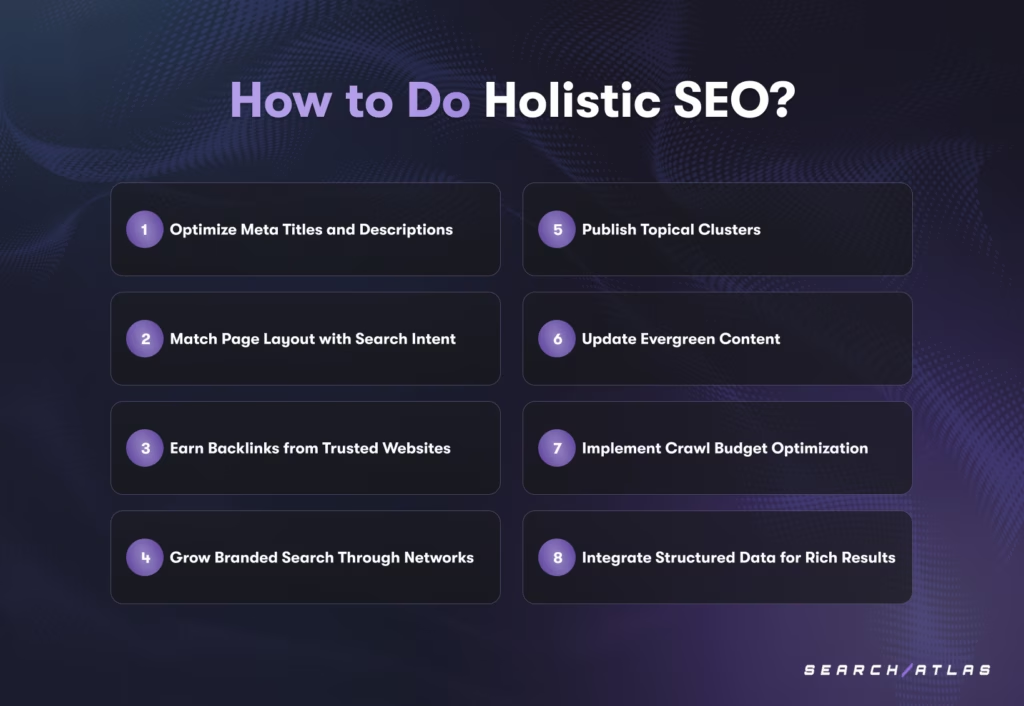
To do holistic SEO, focus on holistic best practices that strengthen rankings across the four pillars of UX, Authority, Content, and Technical SEO.
The 8 best practices for holistic SEO are listed below.
1. Optimize Meta Titles and Descriptions.
Optimizing meta titles and descriptions means writing concise, intent-matching metadata text that encourages users to click on your search result.
Meta titles and descriptions directly impact click-through rate (CTR), which is a core user behavior signal used by Google’s Navboost and Real-Time Engagement (RTE) systems to adjust rankings. Higher CTRs reinforce UX signals, increase branded search behavior (brand-triggered sessions), and amplify authority recognition, which makes metadata optimization a must for holistic SEO.
The best practices for optimizing meta titles and descriptions are listed below.
- Write clear, compelling titles that reflect the actual intent of the target query.
- Use emotional triggers, numbers, or value propositions when appropriate, without misleading users.
- Keep titles between 50-60 characters and descriptions between 120-160 characters for optimal SERP display.
- Include the main keyword in the title and a supporting variant in the description to reinforce relevance.
2. Match Page Layout to Search Intent
Matching page layout to search intent (user intent) means designing and structuring a page to fully satisfy the user’s original query without confusion, delay, or friction.
Page layout alignment directly affects dwell time, bounce rates, and pogo-sticking, which Google tracks through Navboost and RTE systems. A page that matches user expectations keeps visitors engaged longer, increases pages-per-session, and reinforces authority and semantic relevance.
The tips for matching the page layout to search intent are outlined below.
- Front-load valuable content. Start the page with a direct answer, solution, or offer that satisfies the user’s query within the first visible screen.
- Mirror the intent structure. Informational queries should lead with answers, commercial queries should lead with offers.
- Establish a clean, logical heading structure (H1, H2, H3) to guide users quickly through the information they seek.
- Use headings, CTAs, and visual structure to match the content type users are trained to expect from top-ranking results.
- Align page speed, design, and mobile usability to avoid friction that disrupts user flow or causes abandonment.
Use the Search Atlas SCHOLAR (Semantic Content Heuristics for Objective Language Assessment and Review) to test user intent alignment. The Search Atlas SCHOLAR Tool compares your content type against dominant SERP types and scores how well your format, structure, and clarity match real user expectations. A low “User Intent” or “Query Relevance” score signals misalignment.

You can use the SCHOLAR actionable insights to check your content type vs the SERP dominant content type, and then adjust your content accordingly to match the page experience to search intent.

3. Earn Backlinks from Trusted Websites
Earning backlinks from trusted websites means acquiring links from high-authority, topically relevant websites that enhance your website’s credibility and trust profile.
Backlinks remain one of Google’s strongest signals for Authority. In holistic SEO, link equity amplifies every other pillar. Link building supports content discovery, strengthens brand-related UX signals, and reinforces domain-level authority. Google evaluates link trust, context, anchor and annotation text, and network diversity across your domain.
The best practices for link building are below.
- Prioritize links from semantically relevant domains with high Domain Power and low spam risk.
- Avoid anchor text mismatch by aligning the referring page’s context with your content focus.
- Distribute links across topical clusters to support full-domain authority distribution.
- Prioritize backlinks from domains close to trusted seed sites to strengthen PageRank flow.
- Monitor unlinked brand mentions and convert them into backlinks via outreach.
- Reclaim lost or broken backlinks to preserve long-term authority.
Use the Backlink section in the Search Atlas Site Explorer Tool to evaluate the strength, diversity, and trust profile of the website’s backlink network. The Search Atlas Site Explorer Tool reveals core authority signals such as Domain Power, Trust Flow, Spam Score, referring domain history, anchor text distribution, and lost or decaying links.
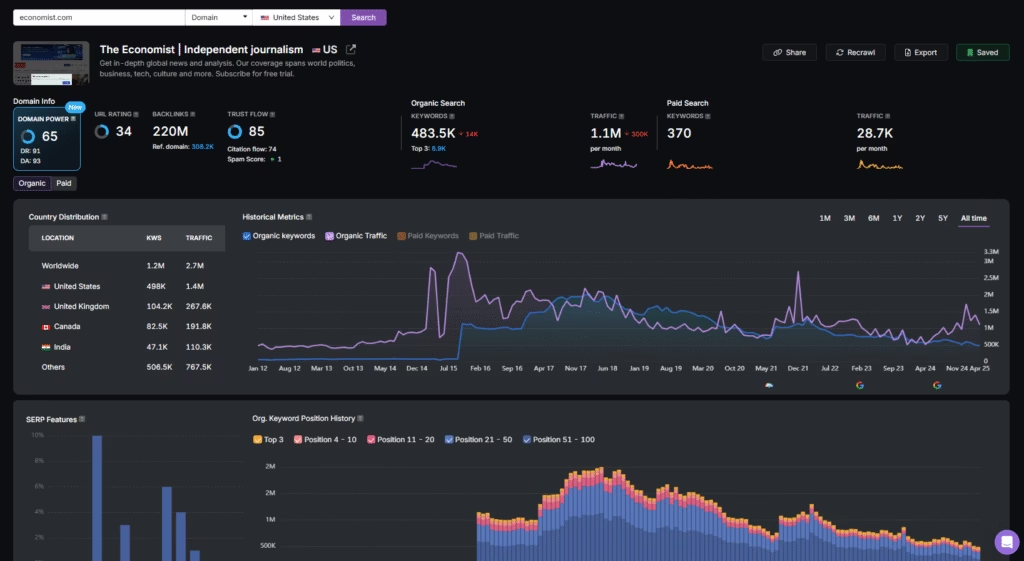
You can use Link Laboratory to acquire high-quality, contextual guest post backlinks from trusted, semantically relevant domains. Link Laboratory is the world’s largest publisher exchange with over 51,000 authoritative websites that accept guest posts, editorials, and press releases.
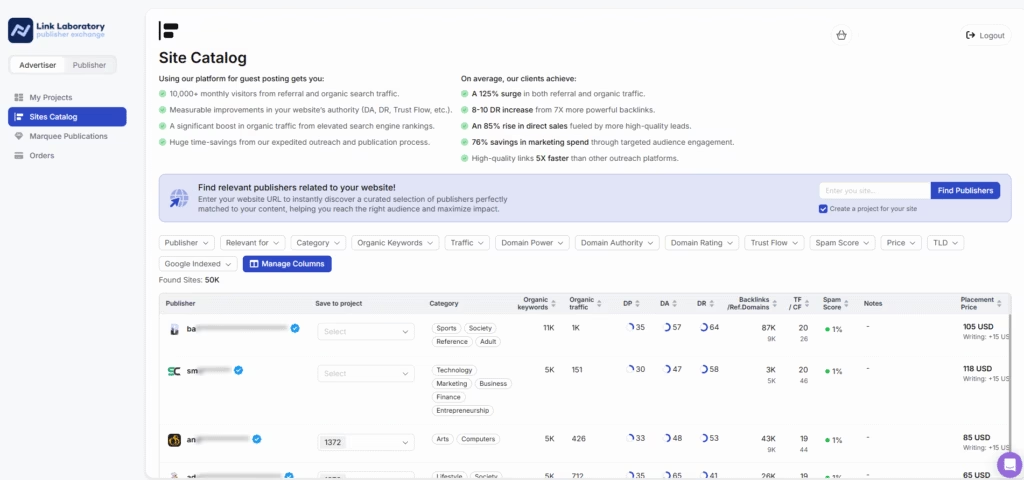
Link Laboratory allows SEO teams to scale authority building by targeting placements that increase Domain Power, DA, DR, Trust Flow, and branded entity recognition. Link Laboratory helps you generate link signals that reinforce topical relevance and long-term trust without triggering spam filters or anchor mismatches.
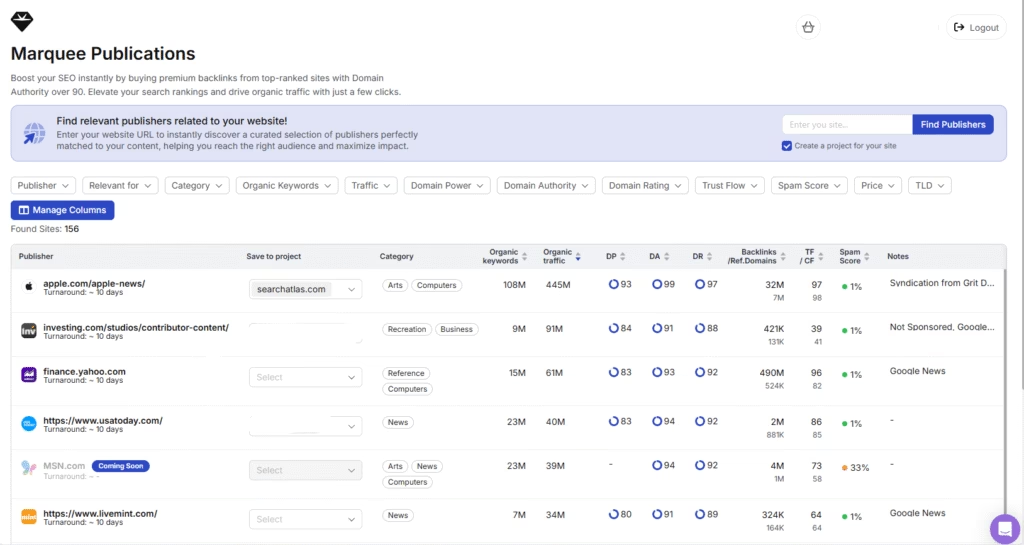
You can use Marquee Publications to get premium backlinks from top-ranked domains with a Domain Authority (DA) of over 90 for instant authority elevation. Marquee Publications offers high-trust placements that appear on elite publishers and help rapidly improve search visibility, PageRank flow, and organic traffic. Marquee links are ideal for brands targeting highly competitive SERPs. They offer a direct path to ranking power with just a few clicks.
4. Grow Branded Search Through Networks
Branded search involves branded navigational queries where users combine your brand name with a specific keyword (e.g., “Search Atlas backlink tool” or “Link Laboratory guest post”). Branded navigational queries reflect user intent that is pre-qualified by brand awareness.
Branded search strengthens User Experience and Authority signals. Branded queries indicate familiarity, perceived relevance, and topical trust. Google’s Navboost and RTE systems treat navigational behavior, especially repeat branded queries, as a quality signal. These behaviors reduce bounce risk, increase CTR, and bias ranking models toward your pages. The result of growing the branded search is a greater ranking preference across competitive keywords, even for non-branded terms.
The best practices for growing branded search through networks are listed below.
- Partner with niche influencers, publishers, and communities to generate brand mentions that lead to organic searches.
- Launch PR campaigns or collaborative content (podcasts, interviews, guest features) to introduce your brand in trusted spaces.
- Promote branded assets through email, social, and paid channels to normalize direct search behavior among cold audiences.
- Repurpose earned exposure (e.g., podcast mentions, expert roundups) across channels to keep brand recall high and search-ready.
- Launch integrated product or service bundles with complementary platforms. Branded mentions in onboarding flows or feature integrations increase your visibility during high-intent user actions.
- Monitor branded query trends using the Search Atlas Keyword tools to track increases in direct search and variations like “[brand] reviews,” “[brand] vs competitor,” or “[brand] pricing.”
Branded search is one of the few SEO levers you can’t fake. It reflects user behavior, memory, and intent, and when it rises, Google interprets it as a signal that users trust your brand over competitors. Partnerships are how you inject your brand into discovery pathways and convert awareness into direct search behavior.
To grow branded search through partnerships, leverage the Search Atlas Link Building Outreach and Digital PR Tool that streamlines outreach to industry publications and influencers. The Search Atlas Link Building Outreach and Digital PR Tool lets you find opportunities, provides customizable outreach templates, tracks communication history, and manages partnership opportunities.
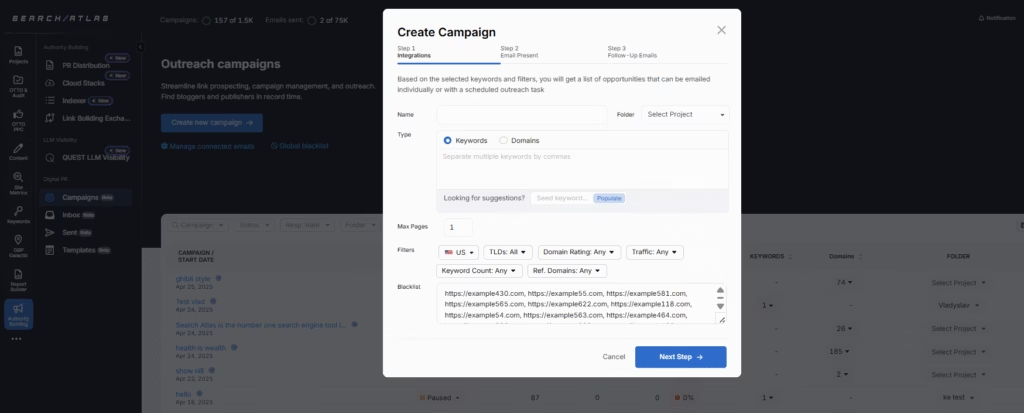
Once you identify target publications, the platform helps you craft branded content pitches that include your company name and key brand terms. After securing digital PR placements, use the platform’s reporting features to track resulting brand mentions and measure increases in branded search volume through integration with Google Search Console data.
5. Publish Topical Clusters.
Topical clusters are structured groups of related content pages that cover a subject comprehensively. A topical cluster includes a core topic page and multiple supporting articles that target semantically linked subtopics. Semantic structure helps search engines understand your expertise and map your domain to a specific knowledge graph entity.
Google prioritizes domains that show consistent, in-depth coverage across a topic space. When you publish content clusters, you strengthen the Content pillar by improving topical relevance, query matching, and semantic saturation. Clusters reinforce Authority and UX pillars by boosting internal linking, reducing bounce rates, and establishing search preference through completeness.
Best practices for publishing content clusters are listed below.
- Create a topical map that outlines every concept, query, and entity related to your core topic.
- Develop pillar pages and link them to supporting content that targets long-tail keywords, questions, and related semantic fields.
- Maintain consistent internal linking to guide crawlers and users through your topic network.
- Update and expand existing clusters over time to maintain content freshness and semantic strength.
The Search Atlas SEO Topical Map Generator tool helps you create entity-based topic structures grounded in semantic SEO. The Search Atlas SEO Topical Map Generator builds clusters of articles around primary topic hubs using keyword intent, search volume, and entity coverage data.
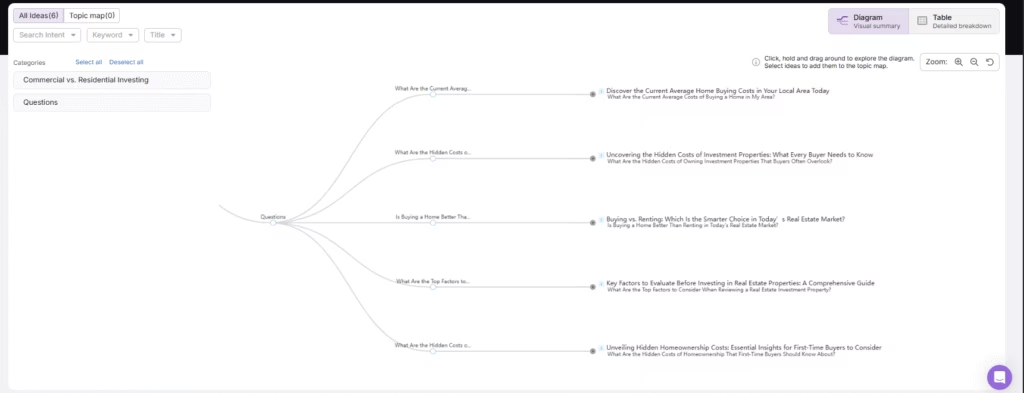
Topical clusters turn your domain into a semantic authority hub. Google rewards depth, structure, and entity precision, and the topical authority approach builds all three.
6. Update Evergreen Content.
Evergreen content refers to articles, guides, and resources that remain relevant over time. Updating evergreen content means refreshing information, improving SEO signals, and expanding semantic depth without changing the core topic or purpose.
Google ranks updated evergreen pages higher because updated content increases content freshness, keyword alignment, and user satisfaction. Old content loses traffic when intent changes or better-ranked alternatives appear. Search engines demote pages when their topics drift or fall out of coverage.
To update evergreen content and maintain semantic relevance, follow the tips below.
- Add new internal links to and from updated evergreen pages to reinforce topical cluster cohesion.
- Expand sections to include new related entities, FAQs, or long-tail variations discovered since the original publish date.
- Refresh metadata (titles, descriptions) to reflect updated search trends and maximize CTR.
- Re-index updated pages through the Search Console or via trusted indexer services to accelerate their impact.
A trusted indexer tool is the Search Atlas URL Indexer Tool. The Search Atlas URL Indexer Tool allows you to resubmit updated URLs instantly and trigger faster re-crawling.
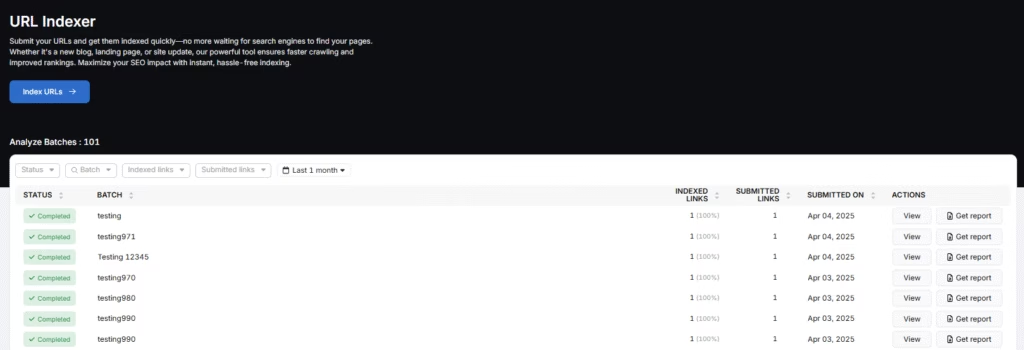
Re-indexing updated content avoids long delays, helps your updated content gain traction faster, and generates improved traffic.
Updated content only performs when the search engines can see the changes.
7. Implement Crawl Budget Optimization.
Implementing crawl budget optimization refers to refining your website’s structure, signals, and server responses to maximize how Googlebot discovers, processes, and indexes high-value content. Crawl budget optimization prevents crawl waste, accelerates indexing, and improves page visibility with semantic weight or conversion potential.
Search engines operate on a finite crawl budget. Google prioritizes crawlable, fast-loading, and structurally sound pages.
In holistic SEO, crawl budget optimization is foundational because it amplifies every other pillar. UX improves when critical pages load fast. Authority spreads when internal linking passes the value to indexable content. Content gains exposure when clusters are completely discovered.
Best practices for crawl budget optimization are listed below.
- Consolidate duplicate URLs using 301 redirects and canonical tags to prevent dilution of crawl signals and link equity.
- Block crawl traps with robots.txt, meta robots (noindex, nofollow), or parameter handling tools.
- Reduce index bloat by de-indexing paginated archives, tag pages, or dynamic faceted URLs that don’t drive traffic or value.
- Submit and maintain XML sitemaps to signal important pages and force the crawl of updates faster.
- Fix soft 404s, redirect chains, and server errors to maintain a clean crawl path.
- Monitor crawl stats to identify crawl spikes, missed pages, or slowdowns.
- Match crawl depth to topical depth, which is critical in clustered content structures where semantic authority depends on full discoverability.
For crawl budget optimization, the Search Atlas Site Audit Tool identifies crawl depth and orphan page issues through its comprehensive crawling engine. The Search Atlas Site Audit Tool contains the Crawl Monitoring feature and the Issues section. The Search Atlas Site Audit Tool provides actionable recommendations and fixes for each technical issue.
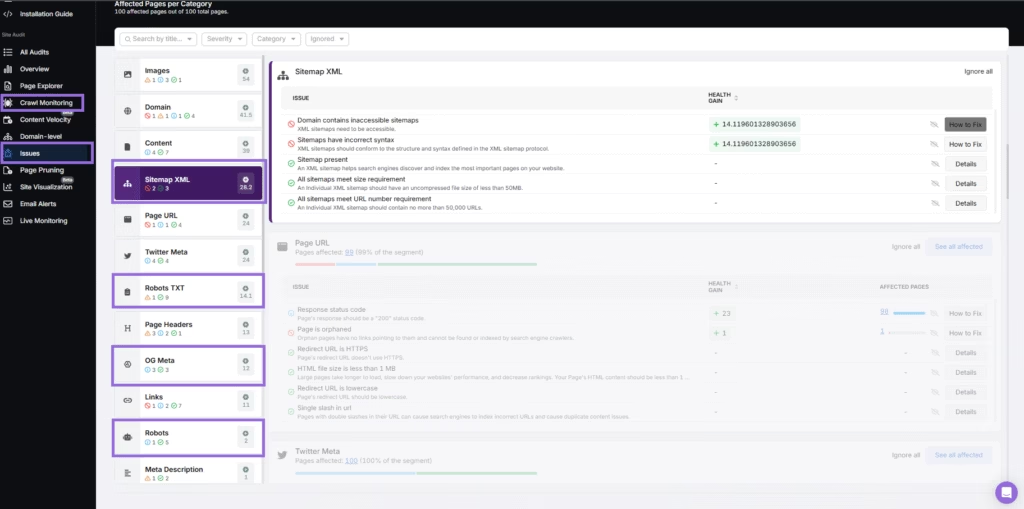
8. Integrate Structured Data for Rich Results.
Structured data is semantic (schema) markup in a standardized format that helps search engines classify your content and enhance how it appears in search results. Structured data powers rich results like star ratings, FAQs, event dates, and article metadata. Schema markup makes your listings more indexable and clickable.
In holistic SEO, structured data supports all four pillars. For UX, structured data improves SERP visibility and engagement. For Authority, it connects your site to recognized entities. For Content, it clarifies content type, purpose, and scope. In Technical terms, integrating structured data aligns with Google’s machine-readable protocols.
The best practices for integrating structured data are listed below.
- Use JSON-LD format per Google’s recommendation for clarity and compatibility.
- Always mark up content with the most specific schema type, e.g., Article, Product, FAQPage, or LocalBusiness.
- Include the author and publisher schema on all articles. Use Person for individuals and Organization for brands.
- Fill out all required and recommended fields, including headline, image, datePublished, and publisher.logo.
- Add sameAs links in the Person schema to connect author profiles to trusted platforms like LinkedIn, Twitter, or Google Scholar.
- Avoid markup errors like mismatched field types, missing properties, or irrelevant schema types on pages.
You can generate and validate a schema easily using the Search Atlas Schema Markup Generator. The Search Atlas Schema Markup Generator Tool provides preconfigured templates for Articles, FAQs, Local Businesses, and more.
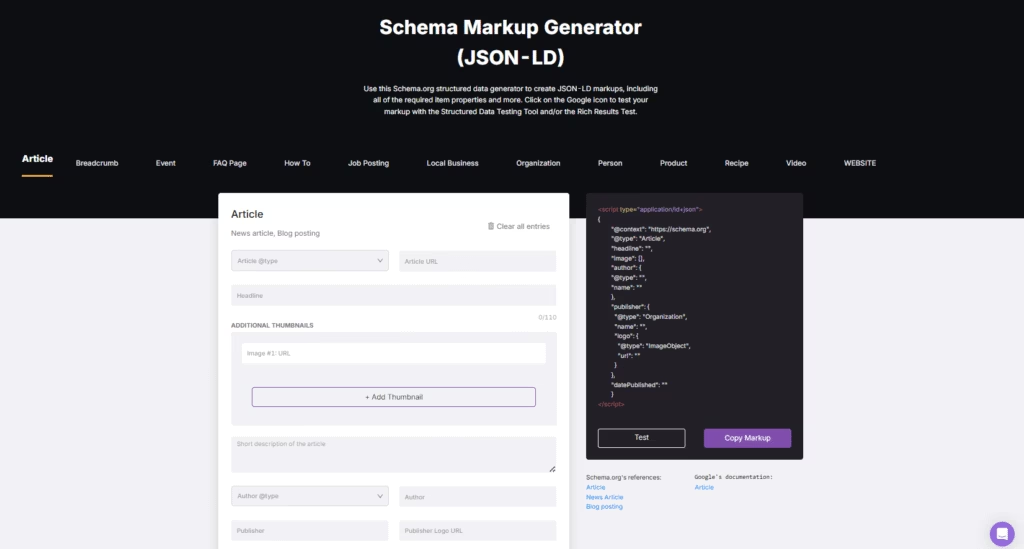
Once you input the values, the Search Atlas Schema Markup Generator produces a clean, valid JSON-LD markup you can paste directly into your site. You can test each generated script instantly using the built-in integration with Google’s Rich Results Testing Tool.
How to Improve Holistic SEO Using Search Atlas OTTO SEO?
Search Atlas OTTO SEO is a holistic SEO AI agent that automates optimizations across the four core pillars of User Experience (X), Authority (A), Content (C), and Technical (T). Search Atlas OTTO SEO identifies performance issues, semantic gaps, and indexation problems, then deploys AI-generated fixes directly to your site using a dynamic JavaScript pixel.
OTTO SEO functions as a site-wide optimization engine, designed to meet Google’s real-time ranking systems (Navboost, RTE, PageRank) by delivering scalable improvements to every signal Google measures.
Search Atlas OTTO SEO improves UX performance by adjusting on-page performance and visual metadata as listed below.
- OTTO SEO injects optimized title tags, meta descriptions, and OG/Twitter cards to increase SERP click-through rates and social share performance.
- OTTO SEO corrects H1–H4 structures for accessibility, readability, and content scannability.
- OTTO SEO uses display:none injections for non-visible improvements (e.g., missing headers or keyword phrases) to preserve UI while satisfying crawler expectations.
- OTTO SEO validates Core Web Vitals via integration with the Search Atlas Site Audit Tool, ensuring fixes do not negatively affect layout shift, interactivity, or load speed.
Search Atlas OTTO SEO supports authority building through link generation and indexing tools as listed below.
- OTTO SEO suggests and replaces redirected internal links with final destination URLs to preserve link equity and improve crawl flow.
- OTTO SEO integrates with Cloud Stacks to generate AI-written articles with backlinks hosted on high-authority cloud domains (AWS, GCP, GitHub).
- OTTO SEO participates in WILDFIRE, a 2:1 backlink exchange network that reinforces domain power via topically relevant partnerships.
- OTTO SEO offers Instant Indexing and Dynamic Indexing to rapidly push new or updated URLs to Google, accelerating authority flow and visibility.
Search Atlas OTTO SEO identifies missing keyword opportunities and semantic gaps in the content through your connected GSC data as listed below.
- OTTO SEO injects missing keywords into page HTML invisibly when they are present in GSC but absent from the page, closing keyword-content mismatches.
- OTTO SEO suggests and deploys internal linking opportunities between thematically similar pages based on content analysis.
- OTTO SEO auto-generates and deploys FAQs with NLP-enriched schema markup to improve query match and featured snippet eligibility.
- OTTO SEO builds topical maps around a core keyword and uses those to generate semantically aligned AI articles, creating entity-rich content clusters.
Search Atlas OTTO SEO automates most foundational technical SEO tasks as listed below.
- OTTO SEO deploys fixes for missing or malformed schema across articles, FAQs, organizations, and products.
- OTTO SEO injects or corrects canonical tags to avoid duplicate indexing and consolidate ranking signals.
- OTTO SEO flags and fixes missing image alt text, injecting keyword-rich descriptions to improve crawlability and accessibility.
- OTTO SEO resolves Twitter and Open Graph card errors to support content performance across social and structured SERP snippets.
- OTTO SEO includes Autopilot mode, which crawls your site on a recurring schedule (e.g., every 7 days) to deploy new fixes automatically.
All fixes are deployed client-side and cached for performance. Nothing touches your CMS directly, and you can manage every change from the OTTO dashboard.
Search Atlas OTTO SEO is not just an automation layer, but a dynamic, real-time ranking enhancement system. OTTO SEO improves all four XACT pillars using AI-driven fixes and semantic intelligence to align your website with Google’s algorithmic expectations.
How Holistic SEO Strategies Align with SEO Ranking Factors?
Holistic SEO strategies align with SEO ranking factors because they strengthen every signal Google evaluates for ranking.
LinkGraph and Search Atlas created the Holistic SEO framework to group all SEO ranking factors into four core categories of XACT – User Experience, Authority, Content, and Technical SEO. The four XACT pillars reflect how Google ranks websites using systems like Navboost, PageRank, Core Web Vitals, and the Helpful Content System.
Google does not rely on one signal. Google evaluates the relationship between hundreds of signals across a domain. Signals include behavior patterns (clicks, dwell time), trust signals (branded search, backlinks), semantic coverage (entities, topical relevance), and infrastructure quality (indexing, rendering, schema). Holistic SEO improves ranking because it reinforces all these areas at once.
Instead of tracking thousands of SEO ranking factors and isolated metrics, SEOs can focus on holistic SEO and the four pillars. A holistic SEO approach simplifies decision-making, strengthens long-term site health, and protects against volatility from algorithm updates.
When every SEO pillar supports the others, websites remain stable in rankings even when individual signals shift.
What SEO Tools to Use in the Holistic SEO Approach?
SEO tools to use in the holistic SEO approach need to provide insights across all four XACT pillars. The most effective approach combines free Google tools with comprehensive platforms like Search Atlas that offer integrated solutions for complete website optimization.
Google’s free tools provide essential data for holistic SEO implementation.
Google Search Console offers insights into indexation, performance, and technical issues. Google Analytics 4 (GA4) tracks user behavior, engagement metrics, and conversion data. Google PageSpeed Insights (PSI) and Google Lighthouse evaluate Core Web Vitals and page performance factors.
Google’s tools deliver valuable baseline data but require integration with more comprehensive solutions for holistic implementation.
Search Atlas SEO Platform provides an all-in-one platform for holistic SEO execution with SEO tools like Site Auditor, Site Explorer, Content Genius, Content Planner, and so on.
The Search Atlas Backlink Research Tool and Link Gap Analysis Tool identify authority-building opportunities based on competitor insights.
You can use the Search Atlas Site Audit Tool to identify technical issues, content gaps, and UX problems across your website.
For the content pillar, the Search Atlas Content Genius Tool optimizes content for comprehensiveness, relevance, and structured data implementation.
Search Atlas OTTO SEO automates improvements across all four pillars simultaneously, implementing fixes that typically require multiple specialized tools.
For most organizations, the combination of Google’s free tools with all-around Search Atlas SEO tools provides the coverage you need for adequate holistic SEO implementation.
Is It Worth Specializing in Holistic SEO Services?
Yes, specializing in holistic SEO services is extremely valuable. The holistic SEO approach creates compounding effects that isolated tactics cannot achieve. Holistic SEO specialists deliver superior results because they optimize complete digital ecosystems.
Evidence shows that holistic SEO providers consistently outperform traditional specialists. Companies generate sustainable organic growth when they strengthen all ranking signals together. Holistic SEO is particularly effective during algorithm updates when websites with balanced optimization remain stable while single-tactic sites experience volatility.
Holistic SEO mentors train practitioners to think about SEO as a whole. Holistic SEO consultants understand the interrelationships between technical foundations, content strategy, authority building, and user engagement metrics. Clients recognize the value of working with experts who can coordinate all aspects of SEO instead of multiple specialists with fragmented approaches.
LinkGraph stands as a prime example of a successful holistic SEO company. The Search Atlas platform integrates tools for all four XACT pillars, demonstrating how a unified approach drives measurable results. LinkGraph’s client success stories, numerous case studies, and experiments validate that websites optimized across all pillars experience more stable growth and better resilience against algorithm updates.
For agencies seeking to offer holistic SEO services without building in-house capabilities, White Label SEO services provide comprehensive solutions that can be rebranded. The Search Atlas White Label SEO turnkey services enable marketing agencies to offer complete SEO packages that address all four XACT pillars under their brand.
Enterprise organizations with complex websites particularly benefit from holistic SEO approaches. Search Atlas Enterprise SEO holistic systems coordinate technical infrastructure, content networks, authority building, and user experience optimization at scale.
Is It Hard to Learn Holistic SEO?
No, it is not hard to learn holistic SEO if you follow a structured system and study real use cases. Holistic SEO requires strategic thinking, but the learning curve becomes easier when the system is clearly explained.
A good holistic SEO course breaks down how Google ranks websites using integrated systems like PageRank, Navboost, and the Helpful Content System. These lessons show how to build ranking strength by aligning every signal, not just chasing keywords or backlinks.
Many professionals prefer holistic white hat SEO because it scales safely and adapts better to Google updates. Instead of exploiting temporary loopholes, this method builds long-term stability.
Explore holistic SEO case studies with trusted holistic SEO companies like LinkGraph to see how others apply the holistic SEO model. Case studies reveal how improvements across the four XACT pillars drive ranking growth and domain authority over time.
The SEOTheory by Search Atlas community on Facebook helps new learners ask questions, share results, and follow the latest updates in holistic SEO, automation, and AI. SEOTheory by Search Atlas supports practical learning with real examples from 2,500+ members.
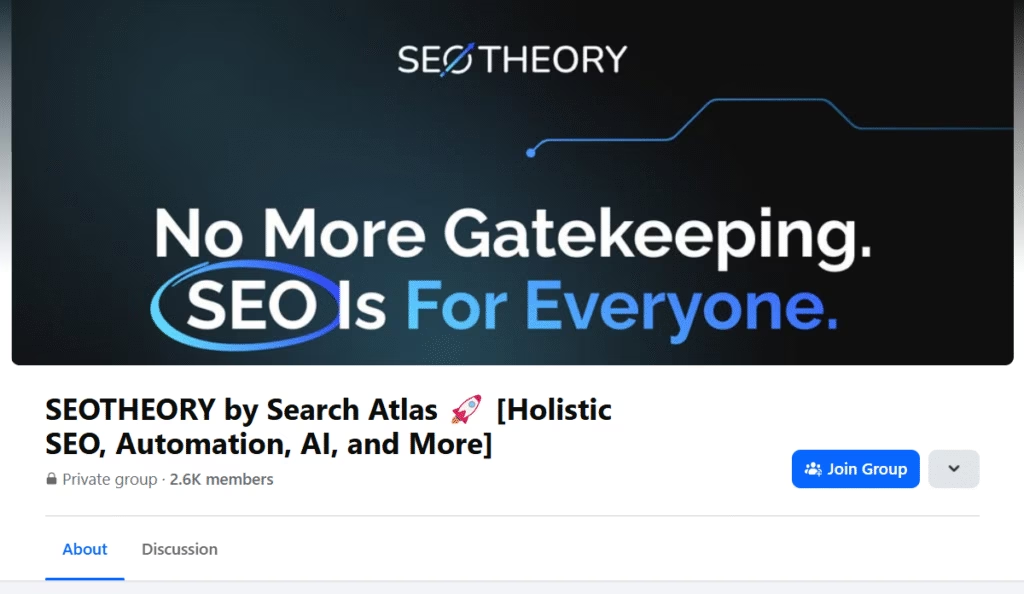
What to Know About Holistic SEO Besides Semantic SEO?
Holistic SEO includes semantic SEO, but semantic SEO is just one part of the content pillar.
Semantic SEO optimizes content by using entities, topical connections, and structured context to match how Google interprets meaning. Holistic SEO uses semantic SEO to strengthen the content layer but expands further to include user experience, link trust, and technical performance.
In practice, semantic SEO helps your page rank. Holistic SEO helps your domain stay ranked by supporting it with signals from all four pillars.
What to Know About Holistic SEO Besides Topical Authority?
Holistic SEO involves topical authority as a measurable outcome of the content and authority pillars.
Topical authority focuses on publishing complete, entity-rich content around a subject. Holistic SEO uses this method and then reinforces it with technical health and behavioral signals to improve stability and ranking velocity.
You gain topical authority by covering topics. You sustain topical authority with holistic SEO that supports crawling, performance, and link equity across clusters.
What Is the Difference Between Holistic SEO and Traditional SEO?
Holistic SEO and Traditional SEO differ in focus, strategy, and long-term impact.
Holistic SEO’s focus is on full-system optimization across user experience, authority, content, and technical performance. Traditional SEO focuses on individual ranking factors like keywords and backlinks.
Holistic SEO’s goal is long-term ranking stability, engagement, and conversion. Traditional SEO aims for short-term visibility based on keyword positions.
For content, Holistic SEO uses entity-based, semantically connected, and in-depth content aligned with user needs. Traditional SEO often relies on keyword-stuffed, volume-driven content that lacks depth and quality.
For UX, Holistic SEO prioritizes page speed, visual clarity, mobile usability, and behavioral signals. Traditional SEO often ignores UX until rankings fall.
Holistic SEO builds authority through trust signals, topical relevance, and high-quality backlinks. Traditional SEO builds authority mainly through link volume and domain metrics.
Holistic SEO is resilient to algorithm updates because it balances all ranking signals. Traditional SEO is vulnerable to volatility when one tactic fails or becomes outdated.
What Is the Difference Between Holistic SEO and Holistic Search?
Holistic SEO is a strategy for ranking websites. Holistic search is a system Google uses to process results across formats.
Holistic SEO involves optimizing a website’s UX, authority, content, and technical layers at once. Holistic search refers to how Google blends sources (webpages, videos, shopping feeds, images, and AI overviews) into one result set. Holistic search connects vertical search systems into one integrated experience.
Holistic SEO prepares your content to appear across multiple entry points in that blended holistic search environment. Pages rank higher when they match the intent, deliver value, and stay structurally optimized.









